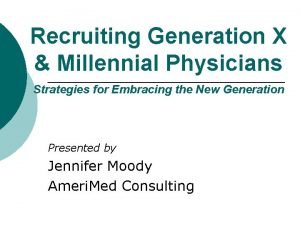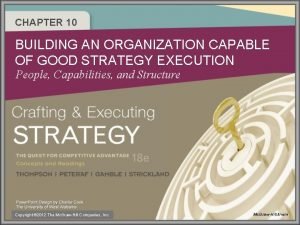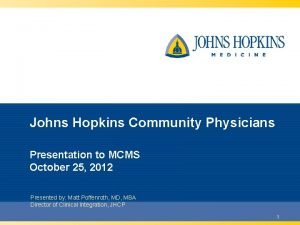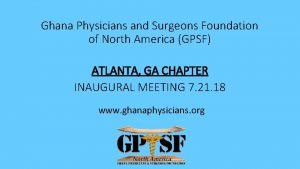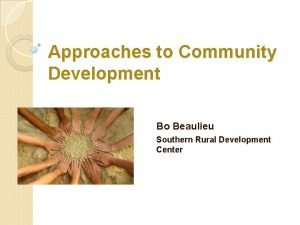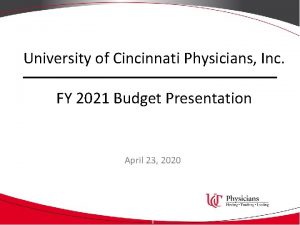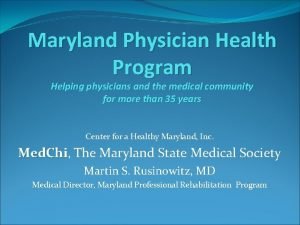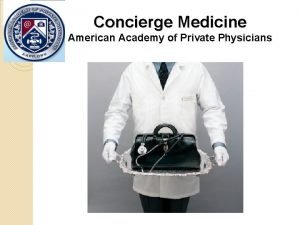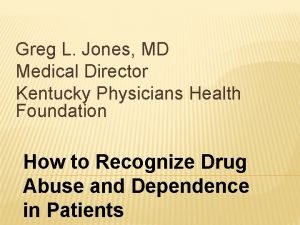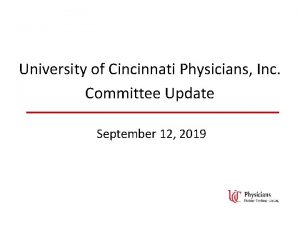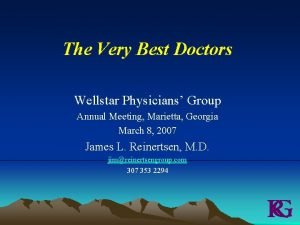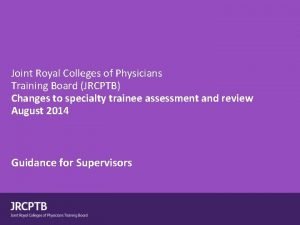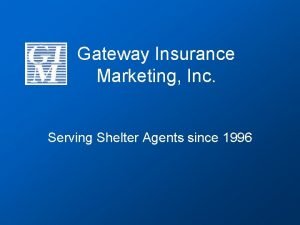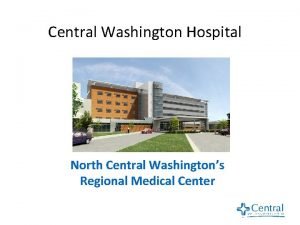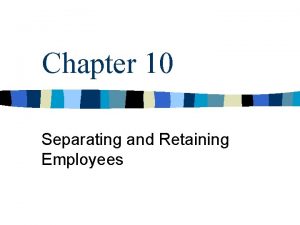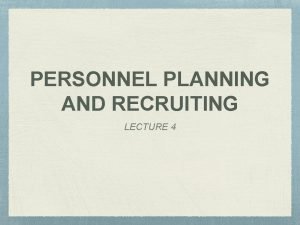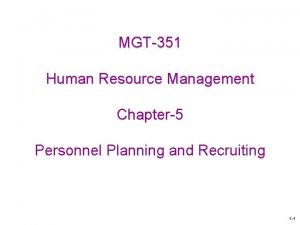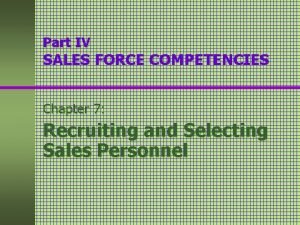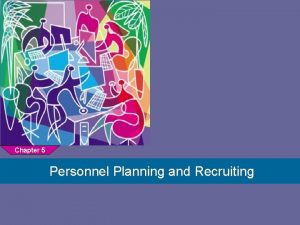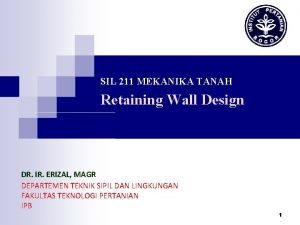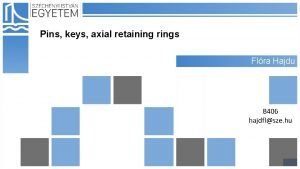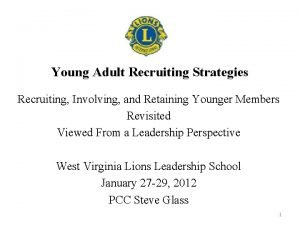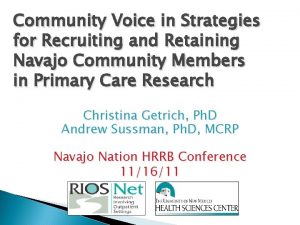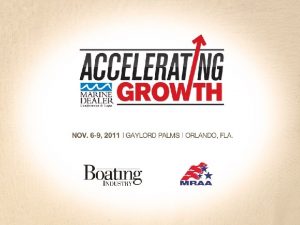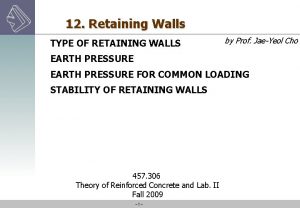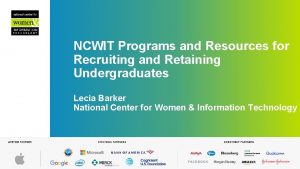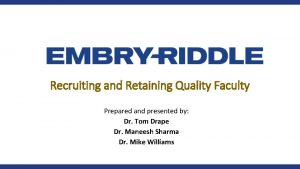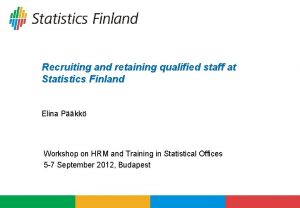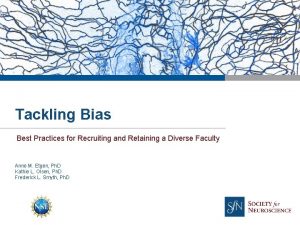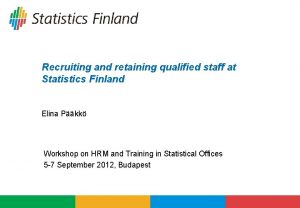Community Approaches to Recruiting and Retaining Physicians and






























- Slides: 30

Community Approaches to Recruiting and Retaining Physicians and Primary Care Providers April 13, 2016 Allison B. Mc. Carthy, Principal 0

Challenges Abound • Aging population • Expanded access • Shifting payment systems • Newer care models • Changing provider needs Trends Ideas from Others Strategies 1

Physician Supply and Demand Projected shortage of 62, 900 and 91, 500 physicians in 2015 and 2020 (active in patient care) – primary care representing nearly 50% 2

Physician Supply Percent in Age 850, 000 active licensed physicians in the US 55 64 65 75 > 75 < 55 3

Age by Specialty Age 55 or Older by Specialty All 42. 60% 41. 30% All Ortho. Surg 52. 30% Thor. Surg OB/Gyn 39. 20% 5. 40% 55. 30% 40% 58. 70% IM 50% Pathology 60. 70% Fam Med 43% 20% Psychiatry Geriatric 30. 40% 10% CV Disease IM/Peds 40. 60% 0% 54. 80% Peds Pulmonary 79% 0% 20% 40% 60% 80% 100% 4

Likely to be Employed Younger Female Primary Care 5

How Does Michigan Stack Up Category Michigan US Average US Median Active Physicians per 100, 000 (29, 166) 271. 9 265. 5 251. 0 Active Patient Care Physicians per 100, 000 (23, 987) 242. 1 234. 7 225. 6 Active Patient Care/ Primary Care Physicians per 100, 000 (8, 756) 88. 4 82. 5 83. 0 Active Patient Care General Surgeons per 100, 000 (705) 7. 1 6. 9 7. 1 Female Physicians as % of Total Active Physicians (8, 768) 32. 0% 33. 2% 32. 4% Active Physicians that are IMGs (7, 891) 29. 3% 24. 2% 18. 6% Active Physicians Age 60 or Older (7, 965) 29. 8% 29. 4% 28. 4% Residents & Fellows per 100, 000 (as of 12/31/14) (4, 995) 50. 4 36. 9 27. 3 Residents & Fellows in Pr. Care per 100, 000 (as of 12/31/14) (1, 732) 17. 5 13. 6 10. 5 Phys Retained from Undergrad Medical Education in MI 43. 6% 38. 7% 38. 5% Phys Retained from GME in MI 44. 4% 47. 2% 44. 4% Phys Retained that did Undergrad and GME in MI 66. 7% 66. 8% 68. 4% 2015 State Physician Workforce Data Book: AAMC, November 2015, based on 2015 AMA Masterfile Green indicates where MI is above the US average and/or median 6

Recruiting Residents • Majority (68%) begin search prior to or early in final year o 32% wait until six months before – fellowships, spouses, visa transitions • Most (93%) prefer communities of 50, 000+ Limited formal learning on medical 63% business – contracts, RESIDENTS APPROACHED BY compensation, coding, RECRUITERS 51 OR MORE TIMES and reimbursement FREE TIME DEBT INCOME 7

Nurse Practitioners “NP” • >80% of NPs were prepared in Primary Care (2012) • 49% of those in Family Medicine (vs. Women’s Health, Peds, Geriatrics) • Many practice in rural or inner city communities • Some opposition from AMA and AAFP relative to Scope of Practice expansion • State based practice distinctions o o 22 States plus D. C. currently recognize “Full Practice” scope for NPs MI Law currently limits their scope of practice to “Restricted Practice” • 2015 mean base salary was $97, 083, with total income of $108, 643 8

2015 Nurse Practitioner State Practice Environment Full Practice Reduced Practice Restricted Practice Source: State Nurse Practice Acts and Administrative Rules, 2015 © American Association of Nurse Practitioners, 2015 Updated 11. 2015 9

Physician Assistants “PA” • • MI ratio of PAs to NPs is 1. 4 : 1 Currently approximately 104, 000 PAs in US 190 accredited programs with annual graduates of 7, 000+ Bureau of Labor Statistics projects that PAs will be the 2 nd fastest growing health profession in the next decade (behind home health aides) 1/3 practice in Primary Care, primarily Family Medicine 1/3 practice in hospital settings 12 15% overall and 20 25% of PAs in Primary Care practice in Rural areas Median Salary in 2013 was $90, 000 (not including bonus) 10

11

Ideas from Others

Address the Shortage • Entering other professions • Consider: o o o “Health Sciences Exploration” or “Clinical Rotations” classes Experience through shadowing, internships, summer jobs or volunteering Science fair awards at local, regional, state levels “Show and Tell Career Fairs” Science class lectures Physician profession used to be self replenishing 13

Early Influencers Health Professions Recruitment and Exposure Program (HPREP) – University of NC School of Medicine • • Expose high school students to medical students, faculty and health professionals Ethnic minority groups across Research Triangle and central NC Collegiate Fellows Program – Southwestern Medical Center • • Nine week summer internship 25 undergraduate students selected Placed throughout hospital and work 40 hours/week Complement academic learning 14

Influence During Med School/Training GME location often matches practice location • Study showed > 40% moved < 10 miles residency; > 50% moved < 75 miles • MU School of Medicine demonstrated that half of graduates from Summer Community Program practice in rural locations. (15 year study) 15

Efforts with Residents Program leadership connections Medical staff Physician leaders Administrators Hosting events Boston Garden North Carolina Zoo System wide career fairs Beyond Sending Flyers Residency/Fellowship Stipends Scholarship awards Early signing bonus Dedicated recruitment FTE 16

Why choose to live in central Michigan? 17

Strategies

Recruitment: Its About Them • Flexibility of schedules o o o Office hours Part time versus full time Call coverage • Employment or private practice o o o Give options Evolve with their self confidence Teach the business aspects of practice • Cover additional training o o Specialist to subspecialist Transition from one setting to another 19

Competitive Compensation • Know what your competitors are offering • Richer retirement packages for practicing physicians • Utilize recruitment incentives • Get creative with incentive bonuses • Consider compensation for administrative activities 20

• Physician as clinical leader • Others as care providers • Also consider: o o Mental health providers Care coordinators Educators/health coaches Substance abuse professionals 5. 6 physicians and 5. 6 MAs Change the Practice Model 1. 5 ACPs 1 Pharmacist 1. 2 RNs 2. 0 LPNs 10, 000 patient panel Group Health, Seattle, WA 21

Succession Planning • Education and mentoring • Emotional support during transition • Evolve out comfortably • Soft place to land • Longer than expected timeframe • Comfortable with “stops” and “starts” Retain the practice and physician as long as possible 22

Increased Differentiation • Distinguish opportunities – beyond geography • Practice opportunity development o o Takes place prior to search launch Unique offerings Office setting Patients Role definition • Define target populations and sourcing strategies o o Attributes of those most likely to be interested Adapt the opportunity to those available 23

Broaden Prospecting Tactics: Michigan Graduates • Target medical schools to identify early prospects o o o Capture list of medical students and residents with contact information Ongoing interactions with program leadership Some programs list residency selections during Match • Establish reasons for med schools to offer information o o o Scholarships and other similar financial offers Career information and/or counseling support for training decisions Special employment offerings for medical students between years one and two 24

Requires Advanced Planning • • Strategic plans Medical staff development plans Succession planning Recruitment cycle o o New graduate season Visa obligations Family relocation preferences Holidays 25

More Aggressive Recruitment Process Candidate Identification To Initial Contact Average Best Practice 1 Week Initial Contact to Pre-Screen Interview 2 Weeks 6 Weeks 3 Weeks 24 hours 2 Weeks 48 hours Limit to one site visit when possible Pre-Screen to Site Visit (s) Site Visit To Offer to Signing 2 Weeks 8 Weeks 19 Weeks 6+ Weeks • • Establish clear candidate criteria Accountability for evaluations Draft contracts in advance Speed candidate closure Compressing the Recruitment Timeframe to Improve Competitive Positioning HCAB Study 2007 26

Other Strategies to Consider • Additional residency program slots • Postgraduate residency programs for ACPs o o Primary care practice Clinical specialty • Training to integrate physicians and ACPs o o o Alter the “shift work” mentality Critical thinking skills Scope of practice 27

Conclusion • Acknowledge reality • Short term and long term perspectives • Collective versus individual efforts • Promotion and differentiation • Continuously streamline process Success Requires: Multiple Strategies… …. Varied Approaches 28

Thanks! Allison Mc. Carthy Principal amccarthy@barlowmccarthy. com
 Recruiting millennial physicians
Recruiting millennial physicians The process of recruiting and retaining capable employees
The process of recruiting and retaining capable employees Jhu community physicians
Jhu community physicians Ghana physicians and surgeons foundation
Ghana physicians and surgeons foundation Self-help approach in community development examples
Self-help approach in community development examples University of cincinnati physicians inc
University of cincinnati physicians inc Maryland physician health program
Maryland physician health program American academy of private physicians
American academy of private physicians Kentucky physicians health foundation
Kentucky physicians health foundation University of cincinnati physicians inc
University of cincinnati physicians inc Wellstar physicians
Wellstar physicians Jrcptb portfolio
Jrcptb portfolio Group 1 and group 2 specialties
Group 1 and group 2 specialties Gateway marketing inc
Gateway marketing inc Physicians in north central washington
Physicians in north central washington Separating and retaining employees
Separating and retaining employees Foundations and earth retaining structures
Foundations and earth retaining structures Retaining wall types
Retaining wall types Attracting and retaining the best employees
Attracting and retaining the best employees Personnel planning
Personnel planning Computerized forecast in hrm
Computerized forecast in hrm Chapter 5 personnel planning and recruiting
Chapter 5 personnel planning and recruiting Nnn promotions interview questions
Nnn promotions interview questions Employee forecasting
Employee forecasting Driver recruiting strategies
Driver recruiting strategies Curtailment of bars in retaining wall
Curtailment of bars in retaining wall Vertical
Vertical Functions of retaining wall
Functions of retaining wall 406 woodruff key dimensions
406 woodruff key dimensions Mass concrete retaining wall
Mass concrete retaining wall Types of lateral earth pressure
Types of lateral earth pressure
